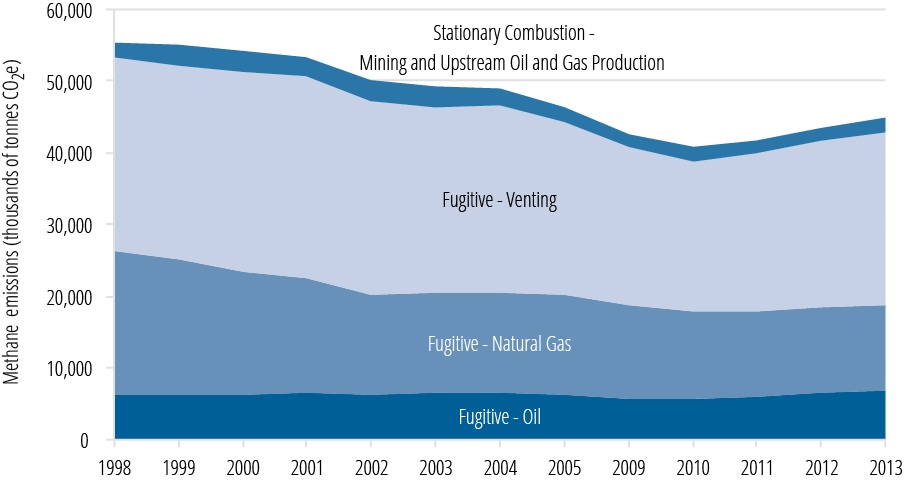
Image credit: @CanadianPM (Twitter).
Today, Prime Minister Trudeau announced that Canada will reduce methane emissions in its oil and gas sector by 40 to 45 per cent below 2012 levels by 2025. This exciting goal, announced in Washington, D.C., will be backed by standards that apply to new and already-built oil and gas facilities. The Prime Minister’s announcement detailed that the government will propose draft regulations to that effect in early 2017. It’s a big win in the battle against dangerous climate change.
Methane, a key component of natural gas, is one of the world’s worst climate pollutants. It’s a short-lived greenhouse gas that packs a big climate change punch: it’s over 34 times more effective at trapping heat in the atmosphere than CO2 and currently accounts for more than six per cent of Canada’s emissions inventory.
Taking bold action to reduce methane pollution quickly and aggressively is a key element of a credible climate action plan. In fact, the International Energy Agency has identified methane emission reductions as one of the world’s best opportunities to tackle climate change. That’s why we’ve prioritized policy solutions on this important issue.

The Pembina Institute has a long record of research in and advocacy for the reduction of flaring, venting and fugitive emissions in Alberta. We were co-chairs of the Clean Air Strategic Alliance’s Flaring and Venting Project Team, whose recommendations were implemented in 1999 and were successful in substantially reducing emissions in the province. But that was only the beginning.
More recently, the Pembina Institute has worked to raise public and decision-maker awareness of the need to take further greater action. Working with partners in the United States, including the Environmental Defense Fund, we have examined and promoted cost-effective opportunities to reduce methane emissions across Canada’s oil and gas sector. Last year, we jointly released research demonstrating that methane emissions from Canada’s oil and gas sector could be reduced by 45 per cent below projected 2020 levels at a cost of only C$2.76 per metric tonne of carbon dioxide equivalent (CO2e). This research helped us make the case to elected officials and the public that managing methane emissions throughout the oil and gas supply chain makes for good climate policy and is backed by a solid business case.
But solving the methane puzzle in Canada is not only about Alberta. In B.C., we created a shale gas tool to analyze and better understand the upstream consequences of oil and gas development, including methane emissions. We also brought a discussion of methane reduction opportunities in B.C.’s oil and gas sector to the province’s Climate Leadership Team (CLT) process. In November 2015, the B.C. CLT’s recommendations to government included a methane target of 40 per cent below 2015 levels by 2021. And just last week, as Canada’s first ministers met in Vancouver to discuss climate change, Premier Christy Clark announced that her government would align its methane efforts with Alberta.
A global climate win in the making
We’re thrilled to see this commitment from Canada today, and we look forward to working with the government as they draft and implement those regulations. Importantly, Canada’s move to regulate both new and existing methane sources in the oil and gas sector has been matched by the White House. President Obama announced today that the U.S. Environmental Protection Agency (EPA) will immediately begin developing regulation for methane emissions from existing sources. Before today, the U.S. EPA planned to implement regulations for new sources, but had not outlined draft regulations for existing facilities.
There will be great pressure now for Mexico to join Canada and the U.S. in adopting this North American methane target. Just last month, the three countries agreed to collaborate on climate and energy issues, including methane regulations. If Mexico takes action on methane, the world’s second, fourth and fifth largest oil and gas methane emitters would be harmonized. Progress on this issue — perhaps at the Three Amigos summit in June — would ratchet up pressure on other fossil fuel producing jurisdictions to follow suit, blazing the path to a global climate victory.
Advancing shared solutions across Canada
This national methane goal comes at a time when Canada’s federal, provincial and territorial leaders are working together to find new policies that will reduce Canada’s emissions in line with our international commitments. Last week in Vancouver, the Prime Minister and the provincial and territorial leaders unveiled a new process, including working groups and public consultation, to close the gap between the country’s current emissions trajectory and existing climate targets.
The development of a methane reduction strategy for Canada — and the subsequent design and implementation of the supporting provincial and federal policies — represents a breakthrough opportunity to tackle emissions in the oil and gas sector. With this momentum in hand, we’re keen to work with Canada’s first ministers to implement today’s commitment. It’s time to get a national methane plan over the finish line.
Ed Whittingham was the Executive Director of the Pembina Institute until 2017.



